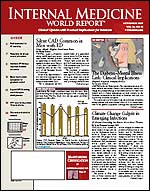Publication
Article
Internal Medicine World Report
Intensive Treatment of Type 2 Diabetes Lowers Mortality
Author(s):
By Caroline Helwick
AMSTERDAM, the Netherlands—Intensive treatment of type 2 diabetes conveys a 50% relative reduction in all-cause mortality, according to the first report of mortality data from the Steno-2 Study (from the Steno Diabetes Center in Denmark).
Steno-2 previously demonstrated that an intensified treatment approach, compared with conventional treatment, reduces the risk of microvascular and macrovascular disease by 50% and conveys a 20% absolute reduction in risk of cardiovascular (CV) end points. The current study, Steno-2 Post, assessed mortality after 13 years of follow-up.
Steno-2 randomized 160 patients with type 2 diabetes and microalbuminuria to intensive, multifactorial treatment or to conventional treatment of risk factors for 8 years. At the end of the study, all 130 surviving patients were offered intensive multitherapy for 5 more years. This primarily included aggressive management of dyslipidemia and hypertension. Lifestyle changes were not part of the intervention.
P
P
Intensive treatment was significantly associated with a reduction in the risk of total mortality, with 24 deaths in the intensive treatment group and 40 in the conventional treatment group. The relative reduction in the total mortality risk was 46% ( = .016); the absolute risk reduction was 20%, based on deaths in 30% and 50% of patients, respectively. Deaths from CV disease were reduced by 57% with intensive treatment ( = .036), with an absolute risk reduction of 13%, reported Peter G?de, MD, of the Steno Diabetes Center, Gentofte, Denmark.
P
Similarly, intensive treatment resulted in a CV event rate of only 31% with intensive treatment, compared with 60% with conventional treatment, for a 59% risk reduction (P = .003). Curves for major CV events also widely diverged ( = .002), he reported.
Differences were observed at 13 years in the occurrence of microvascular disease. Progression to nephropathy was documented in 35 patients with conventional treatment, compared with 20 undergoing intensive treatment; dialysis was initiated in 6 patients versus 1 patient, respectively (P = .039). Similar differences were seen in progression to diabetic retinopathy and autonomic neuropathy.
"The absolute difference in risk is amazing. These results tell us that you need to treat only 5 patients with intensified intervention to prevent 1 from dying after 13 years. That is a very important message and suggests that we have to intervene in type 2 diabetes as early as possible to achieve good results," Dr G?de remarked.





